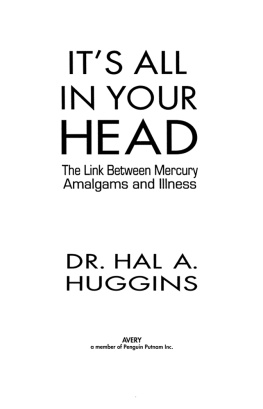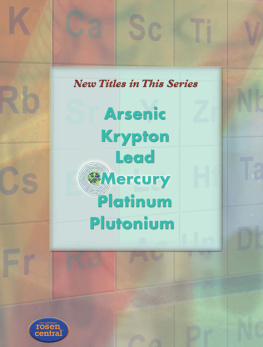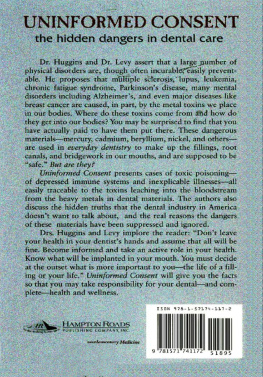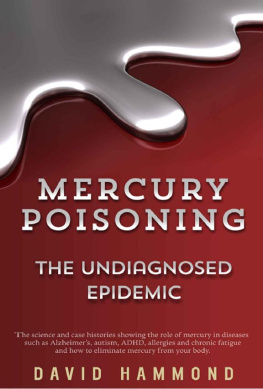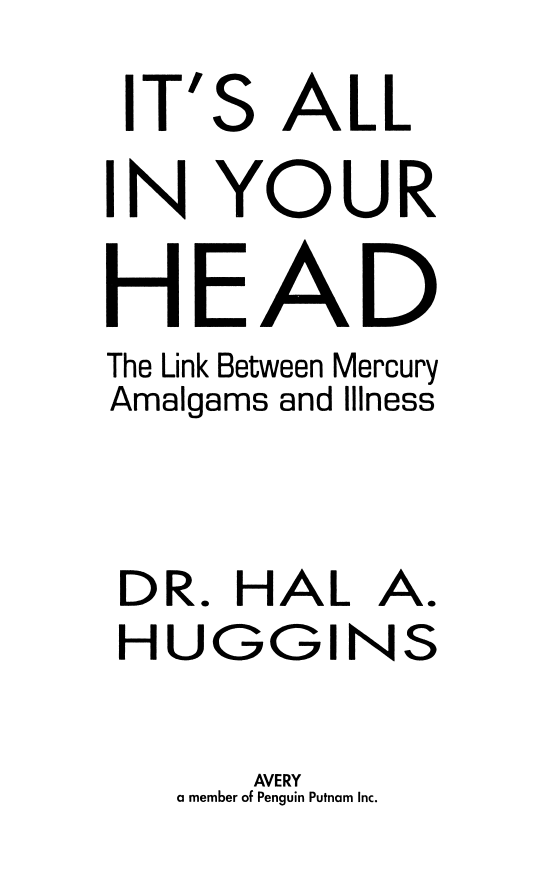
Published by the Penguin Group
Penguin Group (USA) LLC
375 Hudson Street
New York, New York 10014

USA * Canada * UK * Ireland * Australia * New Zealand * India * South Africa * China
penguin.com
A Penguin Random House Company
The excerpts on are reprinted with the permission of Dr. Douglas Swartzendruber.
Copyright 1993 by Hal A. Huggins, D.D.S., M.S.
Penguin supports copyright. Copyright fuels creativity, encourages diverse voices, promotes free speech, and creates a vibrant culture. Thank you for buying an authorized edition of this book and for complying with copyright laws by not reproducing, scanning, or distributing any part of it in any form without permission. You are supporting writers and allowing Penguin to continue to publish books for every reader.
Most Avery books are available at special quantity discounts for bulk purchase for sales promotions, premiums, fund-raising, and educational needs. Special books or book excerpts also can be created to fit specific needs. For details, write .
Library of Congress Cataloging-in-Publication Data
Huggins, Hal A.
Its all in your head : the link between mercury amalgams and illness / Hal A. Huggins
p. cm.
Includes bibliographical references and index.
eISBN 978-1-101-66253-3
1. MercuryToxicology. 2. Dental amalgamsToxicology.
I. Title.
| RA1231.M5H84 1993 93-4660 |
| 615.925663dc20 CIP |
Version_1
Foreword
Dr. Hal Huggins has spearheaded what will go down in medical history as one of the most remarkable movements of rebellion against medicalor in this case dentaltyranny and obstinate pigheadedness ever recorded. And some day, when that rebellion has attained complete successand it willwe all ought to thank him for it.
Certainly its fair to say that if Hal Huggins hadnt been banging the drums to alert us to the dangers of the mercury in our dental fillings, it would have taken many more years before public awareness rose to even the level it has currently reached. Hal wasnt afraid to take on the American Dental Association over silver-mercury amalgams, and in recent years hes been equally willing to expose the dangers of root canals.
All of this has made a significant difference in my medical practice, and its made me aware of the importance of cooperation and teamwork between doctors and dentists. The simple and overwhelmingly significant truth is this: What happens to your teeth can affect your entire body.
When patients tell me, Doctor, for the past two years Ive been suffering from overwhelming fatigue. I dont have the slightest idea what happened to me, one of the first questions I ask is, Did you have any dental work done around the time you first began feeling so tired? A very large percentage of the time, the answer is yes.
Is this a coincidence? I used to ask myself. It was no coincidence. Soon I began asking other categories of patients the same question. Not just chronic-fatiguers, but people with yeast infections, multiple sclerosis, and other neurological disorders often said yes. I was finding out that Dr. Hal Huggins was on to something.
I dont suppose I have to tell you that mercury is a deadly poison and that it doesnt belong in our mouths. Hal is going to explain that in detail. What Ive learned in working with patients is that many people who have silver-mercury amalgams and many people who have root-canal work have simply stepped over the boundary between what their immune systems can tolerate and what they cant. When they do that the message their bodies send is frequently a frightening one.
Dentists are going to have to accept responsibility for the medical problems their techniques create. More importantly, theyre going to have to listen to Dr. Huggins and stop delivering dangerous treatments to their unsuspecting patients. Im quite conscious of the fact that most dentists are men and women of good will who dont know any better. That situation, however, is going to change, and I hope that as it does, more and more conscientious dental professionals are going to join the rebellion against their own organization, the American Dental Association.
We physicians cant afford to be smug. We have our own problems with treatments whose high risk frequently diminishes the intended health benefit toward the vanishing point. (Take a look at the real statistics for heart bypass surgery, and youll know just what I mean.)
Whats essential is that all of us should look to those medical pioneers who are courageous enough to charge full tilt at the fortified ramparts of conventional medical care. The people Im speaking of do not oppose the status quo out of any misguided hunger for controversy and notoriety; they do it because compelling medical evidence has shown them that concealed within standard operating procedures are real and preventable dangers for the folks who really matter in medicineour patients.
Hal Huggins is one of the most distinguished of these pioneers. He is offering dentistry a chance to reform itself and be the important healing art that it can be. Someday we will see the changes he is heralding come to pass, and we will be the better for it.
Robert C. Atkins, M.D.
Preface
Its All in Your Head was written in response to the thousands of calls I have received from frustrated people who had just learned that their fillings contained mercury. Some people wanted the fillings removed immediately, and they wanted to know whom they should see, because their dentists had just told them that they were crazy. Mercury is the safest and longest-lasting common filling that dentistry has to offer, would be the retort. The worst calls, however, came from those who had just had their fillings removed, and who now reported that they were in worse shape than they had ever been. I was frustrated too, because I knew that mercury is toxic, yet the leaders of organized dentistry insisted, It is safe because we have used it for over 100 years.
This is the third time that the mercury debate has arisen. In the 1840s, according to dental lore, European dentists who used the new, cheap, poisonous mercury (quaksilber) fillings were called quaks. Translated into English, quaksilber was called quicksilver, and quak became quack. That era of dentistry is affectionately called Amalgam War One. Amalgam is the generic term for the most commonly used dental filling in the world, silver-mercury amalgam. This pastelike material is a combination of powdered compounds of copper, tin, silver, and zinc, which are added to equal amounts of liquid mercury and mixed together. The combination is then implanted in teeth.
Amalgam War One in the United States resulted in the 1840 demise of the National Association of Dental Surgeons. This association would ban as unethical any dentist who used mercury in a patient. When half the dentists used it anyway, the effectiveness of the organization was lost and it disintegrated into oblivion. Later, it was to be replaced by the American Dental Association (ADA), which favored the use of cheaper mercury fillings over more costly, but safer, gold fillings.
Amalgam War Two came along in the 1920s, led by Alfred Stock, Ph.D. Dr. Stock was a German chemist who himself became forgetful, brainfogged, and ill due to exposure to mercury from his fillings. Upon the removal of his fillings, he noted the return of his intellectual capacities, and he thought it only proper to warn his scientific colleagues of the toxicity of mercury from fillings. He published about thirty scientific articles on the subject, which met with interest from his peers, but with violent reactions from the dental community. After tolerating an inordinate amount of abuse from the dental organizations, he finally dropped the subject, and dentistry continued to place amalgam.

